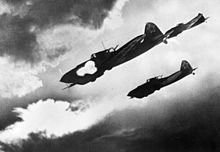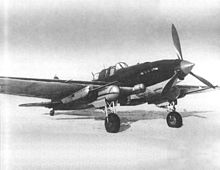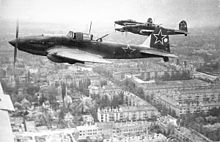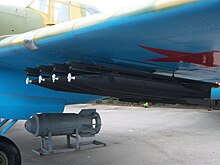Ilyushin Il-2
| Ilyushin Il-2 Shturmovik | |
|---|---|

|
|
| Type: | Attack aircraft |
| Design country: | |
| Manufacturer: | |
| First flight: |
October 2, 1939 |
| Commissioning: |
March 1941 |
| Production time: |
1941 to 1945 |
| Number of pieces: |
36.163 |
The Ilyushin Il-2 " Schturmowik " ( Russian Ильюшин Ил-2 Штурмовик , attack aircraft) is a one or two-seat, single-engine, heavily armored attack aircraft that was used by the Soviet Air Force (WWS) in World War II . It is one of the most built aircraft in the world. The main task of this aircraft was to fight armored vehicles, although it was also used against "soft targets". The Soviets themselves called it "Flying Tank" or affectionately "Ilyusha". German fighter pilots also called the Il-2 a “concrete aircraft” because it could withstand direct hits from a 20 mm cannon and could hardly be shot with machine guns.
history
development
The design was based on Josef Stalin's call for the development of a multipurpose aircraft for the Soviet air force from 1936. It was to be given the name "Ivanov". Although Sergei Ilyushin did not officially participate in this competition, he began to conduct studies on such an aircraft. The core of these considerations was to achieve an optimal combination of mass, armor, firepower and speed. In 1938 his considerations had progressed so far that in a letter to the Central Council of the CPSU on January 27, 1938, he asked that he be entrusted with the construction. His proposal was accepted and officially approved on May 5th.
In January 1939, the technical requirements for the model were issued and construction of the first test model began. The work could be completed in the same year, so that test pilot Vladimir Kokkinaki took off for the first flight with the ZKB-55 on October 2, 1939 (ZKB = Central Design Office ). A second ZKB-55 flew on December 30, 1939. A V12 Mikulin AM-35 engine was used to drive the two-seat aircraft . The factory trials were completed on March 26, 1940 and the ZKB-55 began state trials at the NII ( WWS Research Institute ). It lasted from April 1st to April 20th and certified the type's suitability as an attack aircraft. The heavy armor, which protected the engine, tank, crew and cooling system, accounted for 15% of the total weight; the abbreviation BSch-2 (Russian for armored attack aircraft) was given as a military designation .
However, the military commission criticized the low speed of 362 km / h due to the poor performance of the AM-35 at low altitudes. At Ilyushin's request, the engine designer Mikulin therefore began developing the more powerful AM-38 on his own initiative, which was completed that same year.
When the preparations for the construction of a small pilot series were almost complete, the demand suddenly arose to convert the BSch-2 to a single-seater, as a rear-firing gunner was considered superfluous. Ilyushin therefore rebuilt the first ZKB-55 accordingly and replaced the AM-35 with the AM-38 at the same time. The tests took place as ZKB-57 from October 12 to 22, 1940. Thanks to the more powerful engine, the aircraft reached 423 km / h near the ground. However, the military did not recognize the need for such an aircraft and so there was no order for series production. It was only after Ilyushin and Mikulin met Stalin in December 1940 that the building was personally ordered by him.
After a few changes, preparations for series production began in January 1941 at aircraft factory 18 in Voronezh under the designation ZKB-55P . In the same month the aircraft received the official designation Il-2 . The state testing of the ZKB-55P / Il-2 lasted from February 28 to March 20, 1941 and was carried out by A. Dolgow. At the same time, series production began in February. The first flight of the first series Il-2 took place on March 10, 1941. By the start of the war on June 22, 1941, 249 Il-2s were delivered to the WWS (two in March, 14 in April, 74 in May, 159 in June) . Shortly thereafter, production was relocated to Kuibyshev . The evacuation was completed in the autumn of the same year and the Il-2 was produced in steadily increasing numbers throughout the war and delivered to the front-line units until production was switched to the successor model Il-10 in 1945 .
construction
The Il-2 was constructed in composite construction, steel and aluminum on the front fuselage and wings, the rear fuselage made of glued wooden shells and fabric-covered oars on the tail unit.
The pilot and important parts of the technology such as the engine, cooling and fuel tanks were protected in the early versions with up to 7 mm, later with up to 12 mm thick armor steel . The cabin itself was protected at the front by a 64 mm thick bulletproof glass K-4 . The armored hull (it made up about 15% of the aircraft's mass) was an integral part of the aircraft construction and, unlike other developments at the time, was not mounted separately. It was breached under the fuselage for the coolers. Because of this armor, the aircraft could hardly be fought with machine gun fire. Larger calibers did not necessarily lead to success either, as the projectiles often ricocheted off depending on the angle of impact. The cabin for the gunner, which was added in later versions, was not included in the armor and only received a 6 mm armor plate at the rear.
In the first stage of the war, metal fuel tanks were installed, which cracked at the welds after a few days. When a bullet was hit, the ridge at the exit opening prevented the rubber layer surrounding the tank from contracting again. As a result, tanks were developed made of a special type of paper, so-called leaf fiber, which still held tight during fire tests with the 7.92 mm caliber and 13 mm grenades even after 17 hits. You also saved 56 kilograms of metal per aircraft. Gradually, all Soviet planes received such tanks.
commitment

In the first fights, Il-2 suffered greater losses, due to the lack of hunting protection and the lack of defensive ability to the rear. In addition, the pilots had not yet completed their training on the machine and had not tested any weapons, and there was no operational tactic for the machines. On June 27, 1941, the 4th Attack Wing (which at that time had 64 aircraft) attacked a German tank column for the first time with the Il-2. By July 2, the regiment had lost 20 pilots and 44 Il-2s. By the end of 1941, 1,100 of the 1,500 machines delivered to the air force were lost, with the loss of pilots also having a catastrophic effect. The losses were replaced by pilots who had only been trained on the aircraft for a few hours, some of whom could only fly straight ahead and take off and land with difficulty. Air combat was not taught and so many were shot down on the first use. The 20 mm and 37 mm anti-aircraft guns posed a high level of danger on the ground. In the air, the German fighters achieved high rates of fire when attacking from the side or rear below and from a short distance on the unprotected rear side due to the lack of protection to the rear and the inadequate training of the pilots (they only had to flee in deep flight). In February 1942 it was therefore decided to convert the Il-2 into a two-seater again according to Ilyushin's earlier designs. This model, known as the Il-2M , was tested in March of the same year, and the more powerful AM-38F engine was installed at the same time. The WWS received this Il-2 from September / October 1942. A Beresin UBT machine gun with a caliber of 12.7 mm served as a weapon for the gunner . Since the armor was insufficient for this, high losses resulted. Almost three times as many shooters as pilots were killed in the course of the war.
From spring 1943, the most powerful version, the Il-2M-3, appeared . It had improved flight characteristics and was recognizable by the swept outer wings. It was the most produced Il-2. A small number of these machines received two underwing stations each with 37 mm NS-37 cannons .
Successful Il-2 pilots of the Second World War included the two-time heroes of the Soviet Union Talgat Begeldinow (over 300 missions), Ivan Pawlow (250), Grigory Siwkow (243), Michail Bondarenko (230), Anatoli Brandis (228), Nikolai Semjeiko (227), Alexander Efimow (222) and Leonid Beda (213).
As an attack aircraft, the Il-2 was only effective to a limited extent. It was shown that a targeted attack with high camber angles against small targets was not possible. Therefore, only the approach at an altitude of 400 to 1000 m and the use of weapons with shallow angles up to a maximum of 30 ° remained. An approach at low altitude at high speed did not result in a high hit rate, as the visor only consisted of individual markings on the windshield. In addition, the use of cannons led to strong vibrations and thus to inaccurate shooting results. So only the attack against area targets and in larger associations made sense, the latter only being carried out in 1944.
The Il-2 was ineffective at fighting tanks and other ground targets. The FAB-100 bombs, which were initially used primarily, only worked when they hit less than 5 m from the tank, which was difficult due to the inadequate visor. Even the cannons and unguided missiles could hardly penetrate the armor of German tanks. In addition, there was the low hit rate, which even under firing range conditions was only 3% for the SchWAK and 10% for the WJa , and the lack of radio equipment in the aircraft, which prevented the aircraft from coordinating with each other and preventing them from being controlled from the ground. Only in exceptional cases, such as at the beginning during the Battle of Kursk through the first use of armor-piercing bomb cassettes, which covered an area of 30 m × 100 m, were there good results. According to the aircraft crews, six to eight tanks were destroyed per attack. After the change in combat tactics of the Germans, however, their number fell sharply. However, the losses were also high. In the Battle of Kursk, 255 machines were lost in five days. Between 1941 and 1945 the Soviet Union lost a total of 23,600 machines, 12,400 of them in combat, and more than 7,800 pilots. The total loss rate was an average of 53 bets until loss.
The production figures for all Il-2s built vary from around 31,000 to 36,163 units.
variants
- Il-2U
The two-seat school version (Utschebny samoljot) from 1942, also known as UIl-2, was developed from the single-seat version . It was armed with two 23 mm WJa cannons in the wings, two RS-82 missiles or 600 kg bombs.
- Il-2T
Torpedo bomber (Torpedonosjez) developed in 1943 , equipped with a 533 mm torpedo under the fuselage instead of the usual armament. It was used against ships in the Black Sea .
- Il-2ASch-82 (M-82)
An Il-2M-3 equipped as a test with an ASch-82FN double radial engine. It was tested in the winter of 1943 but did not perform much better. Series production was therefore not carried out.
- Il-2I
A version as a heavy fighter-bomber / fighter (Istrebitel) from 1942. It formed the basic model for the further development of the Il-2, the single-seat Il-1 , from which the Il-10 , which was also built in large numbers, arose.
A further development of the Il-2M-3 with a Mikulin AM 42 engine with 2000 hp and a four-blade propeller. The main landing gear swiveled 90 ° into the wings. It was armed with two 23 mm WJa cannons, two 20 mm SchWAK cannons and a 12.7 mm MG UBK for the gunner. In addition, 1000 kg bombs or optionally eight RS-82 / RS-132 missiles could be carried. The trials took place in the spring of 1944. Series production was abandoned in favor of the Il-10 , which was developed in parallel .
Armament
The armament consisted of machine guns and on-board cannons of caliber 20 mm, 23 mm or 37 mm as well as bombs or unguided air-to-surface missiles RS-82 and RS-132 (caliber 82 mm or 132 mm). From 1943 the very effective shaped charge bomb PTAB was added, which - carried in 48-piece cassettes - became a dreaded weapon against tanks, the armor of which it could easily penetrate from above. A DAG-10 or DAG-5 grenade launcher in the rear shot 2 kg grenades attached to a parachute into the trajectory of an enemy attacking from behind. The Il-2 could also be armed with 150 ASh-2 incendiary bombs . These were small sheet metal balls, each with 1 liter of fire liquid, which ignited on impact.
Trivia
- The Il-2 had the lowest casualty rate of any Soviet aircraft type in World War II.
- The Il-2 was notorious for its firepower among the German troops who gave it the name "Iron Gustav". With the Russian troops it was also known as the "Flying Tank" (Летающий танк) or "Hunchback" (Горбатый).
- Over 100 Il-2s were captured by German troops. However, they were only tested and not used because the aircraft was classified by the Air Force as dangerous for the pilot because it did not meet any technical standards. Finland preferred to receive Soviet captured aircraft until 1944, but did not use the Il-2 either.
Preserved copies
Although the Il-2 was built in very large numbers, only a few examples, mostly flightless, have survived today. The aviation museums in Monino (Russia), Warsaw (Poland), Belgrade (Serbia), Prague and Beijing (China) each have an Il-2.
One of two Il-2s that were still flying was recovered as a wreck from a swamp near Pekow in the 2000s and restored in Novosibirsk over a period of six years. It flew for the first time on September 24, 2011 and is equipped with a V-1710 engine instead of the original AM-38 engine. It is based at Everett Airport and is flown as part of Paul Allen's Flying Heritage Collection .
Another Il-2, which belonged to the 46th Attack Regiment, was damaged in combat operations on November 25, 1943 and had to make an emergency landing on an icy lake near Murmansk , in which it sank when the snowmelt. It was salvaged and restored in 2012. It also received an Allison engine and took off on its second maiden flight on June 16, 2017.
In August 2018, an Il-2 of the early, single-seat version was recovered from a lake near Murmansk from a depth of 18 meters, which had to make an emergency landing on August 22, 1943 and sank after an attack on Luostari airfield. This aircraft is also to be restored to airworthiness.
Technical specifications
| Parameter | Data |
|---|---|
| crew | 2 |
| length | 11.65 m |
| span | 14.60 m |
| height | 4.17 m |
| Wing area | 38.50 m² |
| Empty mass | 4525 kg |
| Max. Takeoff mass | 6360 kg |
| Engine | a Mikulin AM-38 F with 1,720 PS (1,265 kW) |
| Top speed | 410 km / h at an altitude of 1500 m |
| Range | 765 km |
| Service ceiling | 4525 m |
| Armament | two 23-mm-MK WYes two 7.62-mm-MG SchKAS one gunner-MG UBT caliber 12.7 × 108 mm; DAG-5 / DAG-10 grenade launcher in the rear; Incendiary bombs ASh-2 and ASh-4 |
| Gun load | up to 600 kg of bombs (6 × 50 kg, 6 × 100 kg or 2 × 250 kg); eight RS-82 missiles or four RS-132 missiles; four bomb cassettes with 48 PTABs each |
See also
- Suchoi Su-6 - competition model for the Il-2
- Soviet planes in World War II
- IL-2 Sturmovik (computer game)
literature
- Olaf Groehler : History of the Air War 1910 to 1980. Military publishing house of the German Democratic Republic, Berlin 1981, p. 330 f.
- Ulrich Unger: About the creation of the Ilyushin IL-2. In: Horst Skull (Ed.): Fliegerkalender der DDR 1990. Military Publishing House of the DDR, Berlin 1989, pp. 47–57.
- Fliegerrevue 12/76 p. 502–507.
Web links
Individual evidence
- ↑ cf. Olaf Groehler : History of the Air War 1910 to 1980. Military Publishing House of the German Democratic Republic, Berlin 1981, p. 330.
- ↑ Alexei I. Shachurin : Wings of Victory . Berlin 1989, p. 214 f.
- ↑ FliegerRevue September 2015, pp. 52–55, attack aircraft IL-2 .
- ↑ stern.de: The most built aircraft is unknown to most ( memento of the original from December 11, 2010 in the Internet Archive ) Info: The archive link was inserted automatically and has not yet been checked. Please check the original and archive link according to the instructions and then remove this notice. , queried on October 11, 2010, Olaf Groehler : History of the Air War 1910 to 1980. Military Publishing House of the German Democratic Republic, Berlin 1981, p. 331. mentions 36,136 copies delivered.
- ↑ Ilyushin Il-2 / Il-10 in Flieger Revue No. 8/71, p. 358.
- ↑ Michael O'Leary: The only flying Ilyushin IL-2 "Sturmowik". Paul Allen's bang. In: Classics of Aviation, No. 01/2012, p. 37.
- ↑ In flight for the first time since 1943: Ilyushin Il-2 restored . In: FLiEGERREVUE X . No. 66 . PPVMedien, 2017, ISSN 2195-1233 , p. 8 .
- ↑ Ticker message . In: Aviation Classics . No. 2/2017 . Motor Presse, Stuttgart 2017, p. 6 .
- ↑ Newly-Restored Ilyushin Il-2 Sturmovik Flies in Russia. Retrieved June 24, 2017 .
- ^ Another IL-2 recovered in Russia. Retrieved August 19, 2018 .







